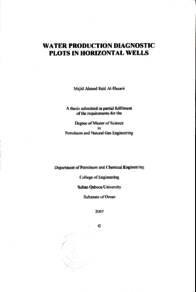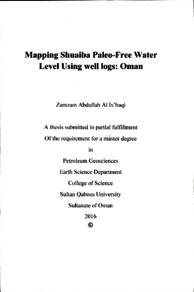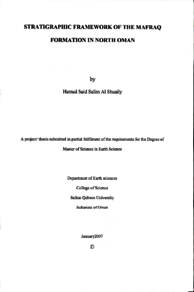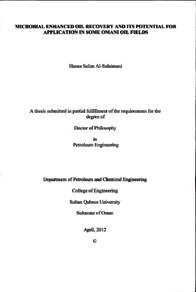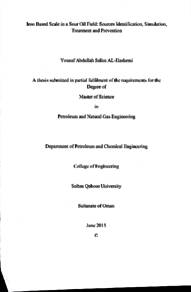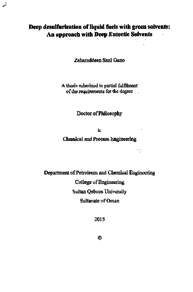Document
High-resolution sequence stratigraphy and heterogeneities in inner carbonate platform systems : examples of the Natih formation, middle cretaceous, Oman : the benefits of outcrop analogue studies to refine the stratigraphic model of an oil field (with reference to the Fahud field, Oman)
Publisher
Sultan Qaboos University
Gregorian
2009
Language
English
English abstract
The Natih Formation was deposited from the Late Albian until the Early Turonian in Oman, Middle East. It is the lateral equivalent to the Mishrif Formation in the UAE and to the Sarvak Formation in Iran, and belongs to one of the most productive oil-bearing carbonate interval in the world. Within this stratigraphic unit, several giant fields are currently in production such as the Fahud field in Oman. The detailed stratigraphic architecture of the Natih Formation and the level of heterogeneity within each reservoir unit are very important to constrain and quantify, since they may have a significant impact on fluid flow and oil-recovery, The Natih Formation corresponds to a very broad, extensive inner carbonate platform that developed over more than 1000 km between the Arabian Shield in the south-west and the Tethys ocean-facing platform margin in the north.. The Natih Formation corresponds to three fully-developed third-order sequences showing the same evolution of depositional system: from a mixed clay-carbonate tabular system at the base to a carbonate-dominated ramp system dominated by rudists and benthic foraminifera above (van Buchem et al., 2002). Intrashelf basins (30 to 40 m deep) developed by differential aggradation within sequence I and sequence III during the major transgressive events of the Late Albian and Late Cenomanian. These three sequences are bounded by one or several exposure surfaces, along which small incised valleys (incisions) can develop.
Because it is overall an aggrading carbonate platform system, the third-order sequences appear very tabular and isopach, which often leads to "layer-cake" correlations, even at the scale of the reservoirs. However, within these third-order sequences, a high level of sedimentary and stratigraphic heterogeneity can develop, and they are linked with the development and fill of intrashelf basins (inclined time lines), phases of subaerial exposure, and phases of flooding of the platform. The present thesis focuses on the study of these heterogeneous stratigraphic intervals.
The methodology used is an integration of analysis at different scales with different techniques. These stratigraphic intervals are studied in detail on several outcrops of the Oman Mountains (Adam Foothills and Al Jabal Al Akhdar). The regional stratigraphic framework is reviewed and extended by regional 3D seismic interpretation. A particular focus is made on specific sediment bodies (channelized structures, sedimentary wedges) on both outcrops and seismic data and the technique of Synthetic Seismic Modelling is used to refine the seismic interpretation of these sediment bodies. Constant iterations between these different observation, outcrop analysis and seismic interpretation, were made in order to build the most accurate sedimentological and stratigraphic model for the Natih Formation.
The results are summarized below:
Heterogeneities linked with the development and fill of intrashelf basins Within the first third order sequence of the Natih Formation, the transgressive systems tract is characterized by tabular to very low angle ramp geometries (progressively increasing, up to 0.3%). These low-angle units are mostly made of muddy carbonate facies and grade downward to organic-rich basinal facies. The highstand systems tract is characterized by progressively steeper sigmoid clinoforms (0.49 to 1). The topsets of these clinoforms are made of aggrading lagoonal facies with nudists and corals in situ, the ramp margin (at the offlap break) is made of high-emergy bioclastic grainstone facies, and the outer ramp is made of muddy carbonate facies with chert nodules in the upper part. The direction of progradation is towards the west in the cast (Adam Foothills area) and towards the east in the west (Fahud field area) Heterogeneities linked with phases of subaerial exposure In the Natih Formation, phases of subaerial exposure are recorded by the development of incisions on the exposed carbonate platform and by forced regressive wedges on the margins of the platform. Incisions are sinuous elongated sediment bodies which are one kilometre wide, twelve-to twenty-metres thick and forty- to more than eighty-kilometres long. They are filled during a transgressive phase with three successive and different fill units. The first part of the fill is to a high-energy lag deposit (good reservoir facies). The second and main part of the fill corresponds to low-energy confined deposits either made of mudstone or green clays (poor to non-reservoir facics) and the last part of the fill corresponds to higher energy deposits, usually organized as large low-angle inclined stratifications complex with stacked reservoir and nonreservoir facies). Forced regressive wedges are "high angie" (20 to 5°) oblique clinoforms mainly made of an alternation of rudstone and floatstone with large rudist fragments. They have a limited 3D extent (15 x 5 km).
Heterogeneities linked with phases of flooding of the platform highly sinuous elongate
In the Natih Formation, phases of flooding of the platform are characterized by the development of tidal channels and associated bioclastic sandwaves and shoals. Tidal channels form sinuous to highly sinuous elongate sediment bodies which are one kilometre wide, three to ten metres thick and twenty to thirty kilometres long. Channel fill and sandwaves are mainly made of course high-energy facies (good reservoir facies) organized as a complex set of carbonate bioclastic sediment bodies, generally corresponding to laterally accreting bedsets with low to high angle inclined stratifications (up to 20%). metres long, Channel fill and suncomplex set of The results of this study have been used to refine the high resolution stratigraphic model of Natih sequence and sequence II in the Fahud field. The integration of 3D seismic interpretation, core study, correlation with outcrops, regional stratigraphic framework and forward modelling has allowed to correlate the Fahud wells with time lines which may better define flow units than lithostratigraphic boundaries. These time lines appear to be more inclined than expected and even downlapping between the wells, since force regressive and lowstand wedges have been interpreted within sequence I. Heterogeneous intervals such as the upper part of Sequence 2, corresponding to the maximum flooding interval, have also been highlighted. A significantly more detailed geological model could then be built for these two sequences, upon which to base the static reservoir models required to assess the re-engineering potential of this mature giant field.
Arabic abstract
تم ترميب تكوين النطيح في عمان خلال فترة الألبي المتأخر الى اوائل فترة التورونیان. يتطبق تكوين النطيح مع تكوين المشرف في الامارات تكوين السرقاك في ايران، حيث يعتبر من أكبر التكاوين الكربونانية المنتجة للبترول في العالم. يوجد العديد من الحقول البترولية العملاقة والمنتجة في هذا التكوين مثل حقل الفهود في عمان، أن الدراسة الطرقية والهندسية التفصيلية لتكوين اللطيح بما في ذلك الاختلافات في كل وحدة من الخزانات مهمة جدا من حيث تحديد وتقييم الخزان لما في ذلك من تأثير على تدقق السوائل واستخراج البترول يمثل تكوين النطيح صفيحة كربوناتية داخلية عريضة وممتدة لأكثر من 1000 كلم بين الدرع العربي في الجنوب الغربي وحدود صليحة محيط التيتس في الشمال، يتألف متكون النطيح من ثلاثة تتابعات متطورة ضمن نظام ترسيبي متشابه يتراوح بين نظام عمداني لخليط من الطين والكربونات في القاعدة الى نظام يغلب عليه الكربونات والروديست المرجاني والفورامنيفرا في الأعلى (2002 ,.van Buchem et al). تشكل حوض قاري داخلي (معمق 30 الى 40 متر) من خلال حت تمايزي داخل التتابع الأول والثالث خلال مرحلة تقدم رئيسية خلال فترة الأوان المتاحر والسينومنيان المتاخر حللت هذة التابعات الثلاثة من خلال تكشفات سطحية عثر فيها على تجويفات صغيرة نظرا لتشكل مكثون اللملي على شكل نظام كربوناتي تظهر التتابعات ثلاثية الترتيب المتكون على شكل صفائحي منتظم يمكن مضاهاة الطبقات فية على شكل الكيك الطبقي وعلى مستوى جميع الخزانات، ولكن قد تظهر بعض الطبقات الغرر متجانسية والتي ترجع الى تكولها في أحواض قارية داخلية (خطوط زمنية مائلة) ومراحل تكشف الى السطح ومراحل فيضانية موضوع هذه الرسالة هو دراسة هذه القطاعات الغير متجانسة علمیت لريقة الدراسة على الجمع بين دمج التحاليل بمقاييس مختلفة مع تقنيات مختلفة. تم دراسة الفترات الطبقية بشكل متوسع في عدة مواقع متکشقة في جبال عمان (تلال أدام والجبل الأخضر). ثم مراجعة الهيكل الطبقي الممتد عن طريق الاستنتاج الميزمي ثلاثي الأبعاد. تم التركيز على أجسام ترسيبية محددة في التركيب القنوية، الوان الترسببية) في التكثفات السطحية والبيانات السيزمية والنمذجة السيزمية لتحسين الاستنتاجات السوزمية للأجسام التسيية. تم جمع واستنتاج الملاحظات وتحليل المكتشفات السلمية للطرقات والاستنتاجات السيزمية لعل نموذج مثالي ودقيق المتكون النطيح.
وتلخص النتائج فيما يلي:
عدم التجانس المرتبط بتكوين والترسيب في الأحواض العقارية الداخلية
تتميز النظام الدي للطبقات الأولى ذات الرتبة الثلاثية من متكون النطيحبشكل هندسي صفائحي بميل خفيف (يزيد ليصل (0 . 3 درجة). تتكون هذه الوحدات قليلة الميل عن محنت كربوناتية طينية وتتدرج في الأسفل إلى سحنات غنية بالمواد العضوية. يتميز النظام الأعلى يميل اعلى احادي الطي ( 0 . 4 الى 1 درجة). يتكون الجزء العلوي من محطك لاجونية رودستية مرجانية مطية المنشا، أما الحواف (فاصل الطبقة) يتكون من سحنات فتية حيوية عالية الطاقة و الجزء الخارجي يتكون من سحنة كربوناتية طينية وعاقدي صوائية في الجزء العلوي الطبقة. اتجاه زيادة العميق هو في الاتجاه الغربي في الجزء الشرقي (منطقة أدام) وفي اتجاه الشرق في الجزء الغربي (منطقة حقل فهود).
عدم التجانس المرتبط بمراحل التعرض على السطح تسجل مراحل التعرض على السطح لمتكون النطيح من خلال تكون سطوح التعميق والقلع للرصيف الكربوناتي من خلال قوى الأجنحة الجزرية على حواف الرصيف. تظهر مظاهر التعميق على شكل أجسام ترسيبي طويلة سينية يصل عرضها الى كيلومتر واحد وبسمك يتراوح بين اثني عشر الى عشرين متر وتمتد مابين أربعين الى ثمانين كيلمومتر تمتلا الحفر التعميقية بثلاثة أنواع من الرسوبيات المختلفة وذلك خلال مراحل المدن الجزء الأول من المواد المالية للحفر تتكون من روسالب متخلفة عالية الطاقة (رواسب خزانية جيدة). الجزء الثاني من المواد يتكون من رسوبيات قليلة الطاقة مكونة اما من الحجر الطيني أو الطين الأخضر (مواد خزانية غير جيدة)، والجزء الثالث يتكون من رسوبيات عالية الطاقة تظهر بشكل واطمح كطبقات مثلة ميلا خفيفا (معقدة التركيب من مواد خزانية الى غير خزانية). الحواف الخزانية تسيل بدرجة عالية (2 الى 5 درجات) لتشكل طبقة أحادية الميل تتكون من طبقا مترادفة من الحجر الروديستي الى الحجر الطافي الغلي ببقايا الروديست ، وتظهر بشكل ثلاثي الأبعاد المحدود (15*15 كلم).
تم استخدام لثلج هذه الدراسة لتحسين النموذج الطبقي عالي المعالم المتكون النطيح في حقل الفهود. لقد ساعد لمج الاستنتاجات السيزمية ثلاثية الأبعاد مع دراسة العينات البشرية ومقارنتها ومضامتها مع التكثفات السطحية والامتداد الطبقي في مضاهاة الأبار المحفورة في حقل الفهود مع الخطوط الزمنية والتي قد تساهم في تحديد وحدات التدفق مقرينة مع الحدود الطبقية الصخرية. لقد تبين أن الخطوط الزمنية تميل أكثر مما هو متوقع، حيث تم تفسير قوة التراجع والحواف المنخفضة ضمن كل طبقة الوحدات الغير متجانسة مثل تلك المتواجدة في الجزء العلوي للطبقة الثانية تمثل أكبر مرحلة فضائية. قد تساهم الدارسة للنموذج الجيولوجي التفصيلي للوحدتين في عمل نموذج خزاني مطلوب لتقديم الطاقة الهندسية لهذا الخزان الضخم.
وتلخص النتائج فيما يلي:
عدم التجانس المرتبط بتكوين والترسيب في الأحواض العقارية الداخلية
تتميز النظام الدي للطبقات الأولى ذات الرتبة الثلاثية من متكون النطيحبشكل هندسي صفائحي بميل خفيف (يزيد ليصل (0 . 3 درجة). تتكون هذه الوحدات قليلة الميل عن محنت كربوناتية طينية وتتدرج في الأسفل إلى سحنات غنية بالمواد العضوية. يتميز النظام الأعلى يميل اعلى احادي الطي ( 0 . 4 الى 1 درجة). يتكون الجزء العلوي من محطك لاجونية رودستية مرجانية مطية المنشا، أما الحواف (فاصل الطبقة) يتكون من سحنات فتية حيوية عالية الطاقة و الجزء الخارجي يتكون من سحنة كربوناتية طينية وعاقدي صوائية في الجزء العلوي الطبقة. اتجاه زيادة العميق هو في الاتجاه الغربي في الجزء الشرقي (منطقة أدام) وفي اتجاه الشرق في الجزء الغربي (منطقة حقل فهود).
عدم التجانس المرتبط بمراحل التعرض على السطح تسجل مراحل التعرض على السطح لمتكون النطيح من خلال تكون سطوح التعميق والقلع للرصيف الكربوناتي من خلال قوى الأجنحة الجزرية على حواف الرصيف. تظهر مظاهر التعميق على شكل أجسام ترسيبي طويلة سينية يصل عرضها الى كيلومتر واحد وبسمك يتراوح بين اثني عشر الى عشرين متر وتمتد مابين أربعين الى ثمانين كيلمومتر تمتلا الحفر التعميقية بثلاثة أنواع من الرسوبيات المختلفة وذلك خلال مراحل المدن الجزء الأول من المواد المالية للحفر تتكون من روسالب متخلفة عالية الطاقة (رواسب خزانية جيدة). الجزء الثاني من المواد يتكون من رسوبيات قليلة الطاقة مكونة اما من الحجر الطيني أو الطين الأخضر (مواد خزانية غير جيدة)، والجزء الثالث يتكون من رسوبيات عالية الطاقة تظهر بشكل واطمح كطبقات مثلة ميلا خفيفا (معقدة التركيب من مواد خزانية الى غير خزانية). الحواف الخزانية تسيل بدرجة عالية (2 الى 5 درجات) لتشكل طبقة أحادية الميل تتكون من طبقا مترادفة من الحجر الروديستي الى الحجر الطافي الغلي ببقايا الروديست ، وتظهر بشكل ثلاثي الأبعاد المحدود (15*15 كلم).
تم استخدام لثلج هذه الدراسة لتحسين النموذج الطبقي عالي المعالم المتكون النطيح في حقل الفهود. لقد ساعد لمج الاستنتاجات السيزمية ثلاثية الأبعاد مع دراسة العينات البشرية ومقارنتها ومضامتها مع التكثفات السطحية والامتداد الطبقي في مضاهاة الأبار المحفورة في حقل الفهود مع الخطوط الزمنية والتي قد تساهم في تحديد وحدات التدفق مقرينة مع الحدود الطبقية الصخرية. لقد تبين أن الخطوط الزمنية تميل أكثر مما هو متوقع، حيث تم تفسير قوة التراجع والحواف المنخفضة ضمن كل طبقة الوحدات الغير متجانسة مثل تلك المتواجدة في الجزء العلوي للطبقة الثانية تمثل أكبر مرحلة فضائية. قد تساهم الدارسة للنموذج الجيولوجي التفصيلي للوحدتين في عمل نموذج خزاني مطلوب لتقديم الطاقة الهندسية لهذا الخزان الضخم.
Member of
Same Subject
